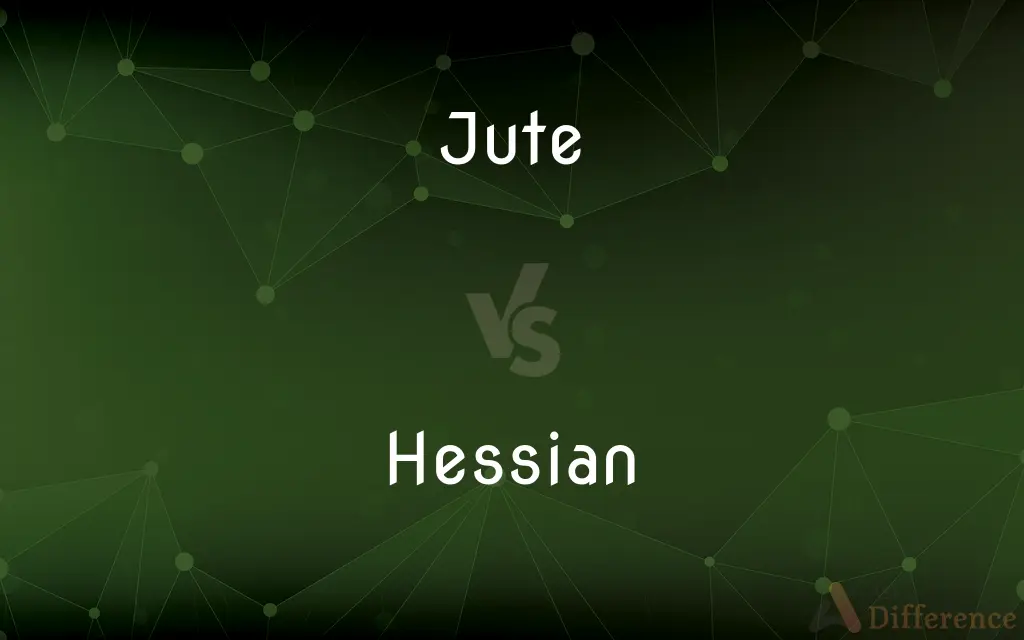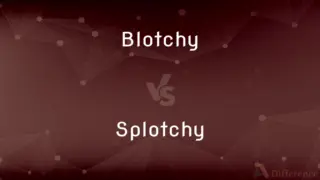Jute vs. Hessian — What's the Difference?
Edited by Tayyaba Rehman — By Urooj Arif — Updated on April 2, 2024
Jute is a natural fiber used in textiles, while Hessian, known as burlap in North America, is a woven fabric made from jute fibers.

Difference Between Jute and Hessian
Table of Contents
ADVERTISEMENT
Key Differences
Jute is a long, soft, shiny vegetable fiber that can be spun into coarse, strong threads. Hessian, on the other hand, refers to the fabric woven from jute fibers, showcasing a coarse and rustic texture. In North America, Hessian fabric is commonly known as burlap.
While jute serves as the raw material harvested from the plant, Hessian represents one of the many products made from jute fibers. This distinction highlights the journey from fiber to fabric, illustrating how jute's natural qualities are transformed into a utilitarian textile. For instance, while raw jute may be processed into refined textiles for apparel, when woven into Hessian, it retains a coarse texture ideal for sacks, bags, and other materials requiring durability rather than fineness.
Both jute and Hessian play crucial roles in eco-friendly practices and sustainable agriculture, given their biodegradable nature and the renewable aspect of jute cultivation. However, their applications diverge based on their form and texture. Jute's flexibility allows for a wide range of products beyond Hessian, including finer textiles and composites, while Hessian specifically refers to the rugged, breathable fabric used in various industrial, agricultural, and decorative applications.
Comparison Chart
Definition
A natural, biodegradable fiber obtained from the jute plant.
A coarse, woven fabric made from jute fibers.
Texture
Varies from fine to coarse, depending on processing.
Consistently coarse and rustic.
ADVERTISEMENT
Primary Use
Wide range, including textiles, twines, and composites.
Sacks, bags, geotextiles, and decorative elements.
Geographic Origin
Primarily South Asia.
Fabric name varies by region (Hessian in the UK, Burlap in North America).
Sustainability
Highly sustainable and biodegradable.
Also sustainable and biodegradable, reflecting the properties of jute.
Compare with Definitions
Jute
Jute's applications range from agricultural uses to home decor.
Jute curtains add a natural aesthetic to interiors.
Hessian
Despite its rough texture, Hessian is used in fashion.
Hessian has been used for creating eco-conscious fashion accessories.
Jute
Jute is a sustainable fiber known for its strength and versatility.
Jute twine is popular for gardening and crafts.
Hessian
Hessian is a woven fabric made from jute fibers, known for its durability.
Hessian sacks are used for storing and transporting grains.
Jute
Jute fibers are spun into coarse threads used in various textiles.
Jute is often used in making eco-friendly bags and rugs.
Hessian
Hessian's coarse texture makes it suitable for various industrial uses.
Hessian is used in landscaping to control soil erosion.
Jute
The fiber is celebrated for its environmental benefits.
Jute decomposes easily, making it an excellent choice for sustainable packaging.
Hessian
It is commonly called burlap in North America.
Burlap is often used in rustic wedding decor.
Jute
It is harvested from the jute plant, primarily in Bangladesh and India.
The jute plant's stalks are processed to extract the fibers.
Hessian
The fabric is also popular in arts and crafts for its rustic look.
Hessian ribbons are a favorite for making homemade decorations.
Jute
Jute is a long, soft, shiny bast fiber that can be spun into coarse, strong threads. It is produced from flowering plants in the genus Corchorus, which is in the mallow family Malvaceae.
Hessian
Of or relating to Hesse or its inhabitants.
Jute
A member of a Germanic people that (according to Bede) joined the Angles and Saxons in invading Britain in the 5th century, settling in a region including Kent and the Isle of Wight. They may have come from Jutland.
Hessian
A native or inhabitant of Hesse.
Jute
A member of a Germanic people who invaded Britain in the fifth and sixth centuries AD and settled in the south and southeast and on the Isle of Wight.
Hessian
A German mercenary in the British army in America during the Revolutionary War.
Jute
Either of two Asian plants (Corchorus capsularis or C. olitorius) yielding a fiber used for sacking and cordage.
Hessian
A mercenary soldier.
Jute
The fiber obtained from these plants.
Hessian
A strong, coarse fabric made from hemp or jute, often used for making sacks.
Jute
The coarse, strong fiber of the East Indian plants, Corchorus olitorius and Corchorus capsularis, used to make mats, paper, gunny cloth etc.
Hessian
Of or relating to Hesse, in Germany, or to the Hessians.
Jute
The plants from which this fibre is obtained.
Hessian
A native or inhabitant of Hesse.
Jute
The coarse, strong fiber of the East Indian Corchorus olitorius, and Corchorus capsularis; also, the plant itself. The fiber is much used for making mats, gunny cloth, cordage, hangings, paper, etc.
Hessian
A mercenary or venal person.
Jute
A plant fiber used in making rope or sacks
Hessian
(19th century) a man's high tasseled boot
Jute
A member of a Germanic people who conquered England and merged with the Angles and Saxons to become Anglo-Saxons
Common Curiosities
What is jute used for?
Jute is used for making textiles, twines, bags, rugs, and as a composite in eco-friendly products due to its strength and biodegradability.
How is Hessian used in agriculture?
Hessian is used for making sacks for storing and transporting agricultural products and as a geotextile for soil erosion control.
Are there any disadvantages to using Hessian?
The coarse texture of Hessian may not be suitable for all applications, especially where a softer material is needed, and it can fray easily if not properly finished.
Can Hessian be dyed?
Yes, Hessian can be dyed, which expands its use in decorative and artistic applications.
Is Hessian suitable for outdoor use?
Yes, Hessian's durability and breathability make it suitable for outdoor use, especially in agriculture and landscaping.
Why is Hessian called burlap in North America?
The name difference is regional; "Hessian" comes from the German soldiers who originally used the fabric, while "burlap" is the common term in North America.
Can jute be used for clothing?
Yes, jute can be processed into finer textiles suitable for clothing, although it's less common than its use in coarser materials like Hessian.
Is Hessian biodegradable?
Yes, Hessian is biodegradable as it is made from jute fibers, which are natural and decompose naturally.
How is jute processed into Hessian?
Jute fibers are harvested, retted, and spun into yarns, which are then woven into Hessian fabric.
What makes jute environmentally friendly?
Jute is environmentally friendly because it's renewable, biodegradable, and requires minimal chemical treatment during processing.
Can jute fibers be blended with other materials?
Jute fibers can be blended with synthetic or other natural fibers to enhance durability, aesthetics, or functionality.
What are the sustainability benefits of using jute and Hessian?
Both jute and Hessian contribute to sustainability through their biodegradability, renewability, and the relatively low environmental impact of jute cultivation and processing.
How long does jute take to decompose?
Jute typically decomposes within 1-2 years when exposed to the environment, depending on conditions.
What are the main differences in the production of jute and Hessian?
The production of jute involves harvesting, retting, and spinning the fibers, while Hessian production specifically refers to weaving those fibers into a coarse fabric.
Share Your Discovery

Previous Comparison
Been vs. Being
Next Comparison
Blotchy vs. SplotchyAuthor Spotlight
Written by
Urooj ArifUrooj is a skilled content writer at Ask Difference, known for her exceptional ability to simplify complex topics into engaging and informative content. With a passion for research and a flair for clear, concise writing, she consistently delivers articles that resonate with our diverse audience.
Edited by
Tayyaba RehmanTayyaba Rehman is a distinguished writer, currently serving as a primary contributor to askdifference.com. As a researcher in semantics and etymology, Tayyaba's passion for the complexity of languages and their distinctions has found a perfect home on the platform. Tayyaba delves into the intricacies of language, distinguishing between commonly confused words and phrases, thereby providing clarity for readers worldwide.














































